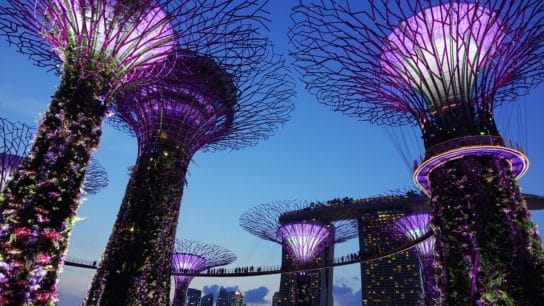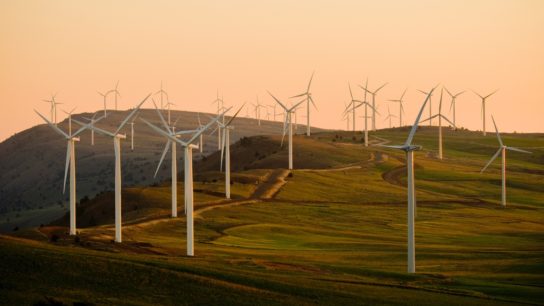Advanced biophilic and sustainable design is gaining traction as architects and developers recognize its decisive role in achieving net-zero carbon goals.
—
This approach goes beyond reducing emissions. It enhances the quality of life by connecting occupants with nature, optimizing light and improving air quality while cutting down energy use.
Advanced sustainable designs can reduce consumption with high-impact materials like low-emissivity (Low-E) glass, high-performance insulation and living green systems. These features make them essential for climate-conscious projects. Investing in these eco-friendly strategies fosters a more harmonious future for people and the planet.
Advanced Biophilic Design in Modern Architecture
Biophilic design is evolving far beyond adding greenery to urban landscapes. Today’s architects create ecosystems within buildings to help foster nature’s essential benefits in dense urban areas. Experts believe the shift toward biophilic architecture can drive sustainability by embedding natural processes into everyday spaces, helping to address urban challenges like resource scarcity and limited access to green areas.
Through innovative features like living walls, rooftop gardens and green corridors, biophilic design reconnects people with nature. It creates urban ecosystems that support biodiversity, manage stormwater and improve air quality. This approach positions buildings as active contributors to urban sustainability, bringing nature’s systems into spaces where they are often missing.
The synergy between biomimicry and biophilia drives this transformation as architects increasingly look to nature for inspiration. By mimicking processes like the self-cooling techniques of termite mounds or the efficient energy capture of leaves, architects can craft buildings that optimize electricity use and create healthier environments for occupants.
Biophilic design offers measurable benefits, from increased thermal comfort and productivity to enhanced emotional well-being. It improves the look of urban spaces and builds a sustainable environment that supports the planet and its inhabitants.
Low-Emissivity Glass in Advanced Sustainable Design
Low-E glass has become fundamental in advanced sustainable design because it offers powerful energy-saving benefits without sacrificing natural light. Minimizing heat transfer and reducing glare help create comfortable, efficient indoor environments that support environmental goals.
The Nature of Low-E Glass
Low-E glass coatings come in two main types – soft-coat and hard-coat. Each offers unique benefits for energy performance in buildings.
Soft-coat Low-E glass provides excellent insulation by reflecting infrared energy, making it ideal for retaining indoor heat in cooler climates. It works best in double- or multipane windows because it is more delicate than hard-coat Low-E glass, which is fused during manufacturing. This process creates a more durable surface suitable for single-pane windows, though hard-coat glass does not insulate as effectively as soft-coat alternatives.
Spectrally selective coatings add versatility by filtering out infrared heat while allowing visible light to pass through. These coatings are particularly valuable in warm climates. They help reduce cooling costs by keeping interiors bright without heat gain, making Low-E glass a key component in energy-efficient, comfortable buildings year-round.
Thermal and Visual Comfort
Low-E glass allows natural light to enter while blocking unwanted heat, helping maintain a stable thermal envelope. Traditional windows can lead to major energy loss, with up to 25% to 30% of residential usage and about 30% in commercial buildings stemming from heat that passes through windows.
Low-E glass reduces this loss by reflecting infrared energy. It keeps interiors cooler during hot months and warmer in the winter, lessening reliance on heating and cooling systems. This selective control of heat and light allows for bright, naturally lit spaces without the added costs.
Integrative Applications
Using Low-E glass with passive solar design and dynamic shading optimizes energy management. Passive solar methods focus on strategically orienting and designing structures to harness sunlight for natural heating in winter. Meanwhile, they block the harsh summer sun to keep interiors cool.
When paired with dynamic shading solutions – such as automated blinds or exterior shades – buildings can adjust to changing light conditions throughout the day. This smart combination reduces energy costs and maximizes natural light, making interiors bright and inviting while reducing the need for artificial heating and cooling.

Sustainable Design Principles for High-Performance Spaces
Design principles for high-performance spaces aim to create resilient buildings that benefit the environment and occupants. Steps like reducing embodied carbon, maximizing resource efficiency and improving indoor air quality can support ecological goals and human health.
Carbon-Neutral Goals
Net-zero design targets innovative, sustainable architecture. It pushes for buildings that balance the energy they consume with the renewable energy they generate. A big part of this goal focuses on reducing embodied carbon – the hidden carbon footprint tied to producing and transporting building resources and the construction process.
The use of sustainable materials like recycled steel or low-carbon concrete creates buildings with lower embodied carbon and longer, more efficient life cycles. This is essential because nearly 40% of the country’s carbon footprint comes from electricity alone. Combining smart material choices with practical design elements lowers a building’s environmental impact and supports a cleaner, greener future.
Material Transparency and Life Cycle Assessment
Full life cycle analysis helps architects and developers make material choices that benefit the environment long-term. This approach considers the entire journey of the material – from production and transport to use and disposal – to ensure the environmental impact is low at every stage.
Environmental Product Declarations (EPDs) are crucial in this process because they offer transparent, standardized data on a material’s carbon footprint, energy consumption and emissions. With EPDs, designers can make informed choices aligned with sustainability goals. They can select materials that support a building’s efficiency and eco-friendliness from start to finish. By focusing on full life cycle analysis and EPDs, designers can reduce emissions and set up projects to be environmentally responsible for decades.
Operational and Embodied Energy
To create eco-friendly spaces, sustainable design must address energy usage during a building’s life along with its embodied energy. Buildings in the US account for 75% of all electricity use, underscoring the need to cut operational and embodied energy to move closer to ecological goals.
Usage during a building’s life covers everything needed for daily operations, from heating and cooling to lighting and appliances. Strategies to lower this rate include installing efficient HVAC systems, using LED lighting and drawing on renewable sources like solar power.
Choosing low-impact materials – like recycled metals or low-carbon concrete – can reduce a building’s environmental footprint before it is occupied.

Integrating Sustainable Materials
Incorporating Low-E glass and other efficient materials into biophilic and sustainable design can greatly enhance a building’s energy performance and environmental impact. The careful choice of resources and design elements creates spaces that maximize natural light, reduce demands and foster a deep connection with nature.
You can integrate Low-E glass and other sustainable materials into your biophilic design through these practical steps:
- Define energy and environmental goals: Establish clear efficiency and sustainability targets to guide material and design choices based on project needs.
- Analyze climate considerations: To optimize heat retention or reflection, select the appropriate type of Low-E glass based on local climate conditions. For example, flat glass covers over 50% of the exterior surface area in modern skyscrapers. However, it conducts heat quickly and results in higher consumption.
- Consult with sustainability experts: Engage a consultant to conduct a life cycle assessment, ensuring materials have low embodied carbon and high EPDs.
- Orient the building for solar benefits: Plan window placements and building orientation to leverage passive solar heating in colder months and avoid excess heat gain in warmer months.
- Incorporate dynamic shading systems: Use automated blinds or louvers to adjust shading and allow natural light without excessive heat.
- Add biophilic elements thoughtfully: Integrate natural materials, living walls and green roofs to enhance indoor air quality and foster a stronger connection with nature.
- Target green building certifications: Aim for certifications like LEED or WELL, which provide a framework for incorporating sustainable practices and efficient materials throughout the design process.
These steps create structures that meet performance standards and enrich occupants’ connection with the natural environment.
Exploring these advanced strategies for incorporating Low-E glass and sustainable materials allows architects to push the boundaries of what’s possible in environmental design. By adopting these techniques, it’s possible to create areas that are energy-efficient and deeply connected to nature.
You might also like: Exploring the Economic and Social Benefits of Sustainable Buildings














